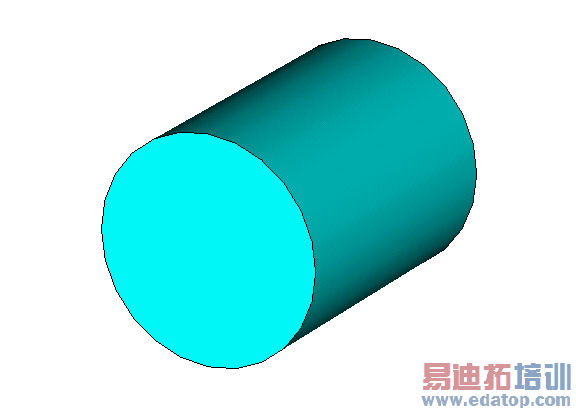- 易迪拓培训,专注于微波、射频、天线设计工程师的培养
Cylinder Resonator - CST2013 MWS Examples
Hexahedral mesh:
Tetrahedral mesh:

General Description
This example demonstrates a simple eigenmode calculation. The structure is a cylinder with perfectly conducting walls and vacuum inside. Q-factors are calculated in the postprocessing step.
Structure Generation
The background material is defined as perfectly conducting material, the units are changed to centimeters and megahertz, and the boundary conditions are set to "electric" in order to model perfectly conducting walls.
The cylindrical resonator is created by adding a solid cylinder to the vacuum layer. Its dimensions are defined by two parameters (length "l", and radius "r"), so that its geometry can be changed easily.
Mesh settings
Both the number of lines per wavelength and the lower mesh limit are increased to 15 for the hexahedral mesh. Curved element order property for the tetrahedral mesh is set to 2.
Solver Setup
The number of modes is changed in order to consider only three eigenmodes. When the eigenmode solver is started, the three lowest resonance frequencies of the structure are calculated. Please note that mode 1 and mode 2 are identical except for polarization.
Post Processing
The resulting mode information is listed in the navigation tree in the folder 2D/3D Results, subfolder Modes. Here the mode patterns as well as the corresponding eigenfrequencies can be found. The resonance frequencies are also stored in the logfile of the eigenmode solver.
Depending on the dimensions of the cylinder the analytical solution of the first two eigenfrequencies can be written as
f_res(TE_111) = 0.5 * c * sqrt((1/L)^2 + 0.344 * (1/r)^2)
f_res(TM_010) = 0.3828 * c / r
(c = speed of light in the observed medium)
The default parameter settings (l = 40 cm and r = 15 cm) yield the following first three resonance frequencies:
1. | 695.686 MHz |
2. | 695.686 MHz |
3. | 765.090 MHz |
The quality factors are calculated using 'Results/Loss and Q calculation'. For a conductivity of 5.8*10^7 S/m, the analytical values for mode one to three are given by
1. | Q = 40579 |
2. | Q = 40579 |
3. | Q = 42390 |
CST微波工作室培训课程套装,专家讲解,视频教学,帮助您快速学习掌握CST设计应用
上一篇: Circular Patch Antenna - CST2013 MWS Examples
下一篇: Circular Resonator - CST2013 MWS Examples
 最全面、最专业的CST微波工作室视频培训课程,可以帮助您从零开始,全面系统学习CST的设计应用【More..】
最全面、最专业的CST微波工作室视频培训课程,可以帮助您从零开始,全面系统学习CST的设计应用【More..】
频道总排行
- Rectangular Waveguide Tutorial
- FSS: Simulation of Resonator
- CST2013 MWS Examples: Thermal C
- Dipole Antenna Array - CST201
- CST MWS Examples - CST2013 M
- Microstrip Radial Stub - CST2
- Dielectric Resonator Antenna -
- Interdigital Capacitor - CST20
- CST2013 MWS Examples: Biological
- Lossy Loaded Waveguide - CST2
